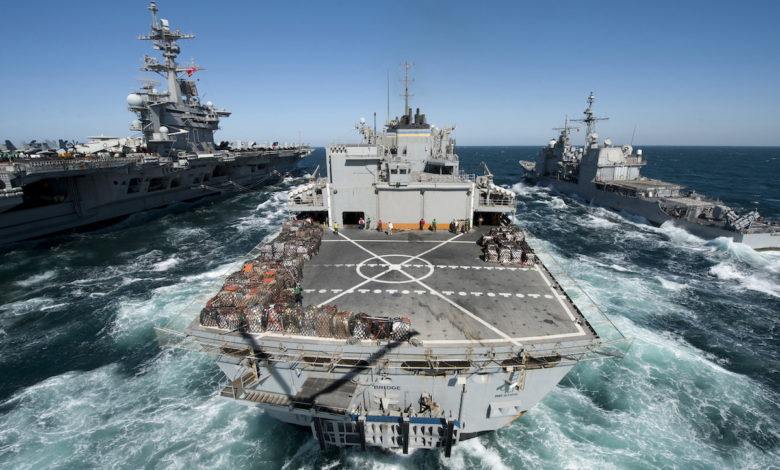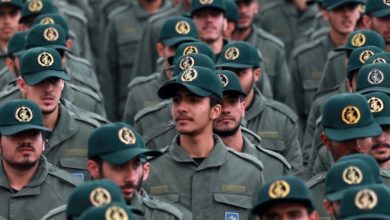
The United States has increased its military presence in the Persian Gulf, raising the risk of an armed conflict against Iran. In early August, the military announced the deployment of 3,000 Marine and Navy personnel. The military escalation includes helicopters, amphibious landing vessels and additional fighter jets, including F-35, F-16 and A-10 aircraft, and guided-missile destroyers.
The stated purpose of this escalation is for the United States to provide security to the Persian Gulf, in particular the Strait of Hormuz. According to the United States, “Iran has either seized or attempted to take nearly 20 internationally flagged ships in the region in the past two years.”
The specific ways in which the U.S. military intends to use this force is not clear. Some statements suggest that the heightened presence is intended to serve as a deterrent to Iran’s active naval presence. But senior U.S. Defense Department officials in Central Command have reportedly worked on a proposal to enable the military to intervene more directly. The proposal includes plans to have Marines “offer protection” by boarding civilian commercial ships flying foreign flags.
It is not clear whether the plan will receive final approval by Washington. The implementation of this plan would also require approval by the regional governments. Additionally, individual private shipping companies would have to authorize the boarding of the Marines on their ships. Still, if any portion of this plan becomes operational, the chance of military clashes between Iran and the United States will increase ten fold. With the U.S. Marines on board, what could have been an inspection of a commercial ship by Iran’s Navy can then turn into a gunfight.
Is Iran really a threat to commercial shipping?
Even going by U.S. numbers, it is hard to see how the “seizure or attempted takeover of nearly 20 ships” over the course of two years constitutes an emergency. That is an average of less than one a month. Additionally, as Iran’s Navy has pointed out, some of the “seizures” have been cases of the Iranian Navy responding to distress signals from the commercial ships. None of these cases have involved fatalities or serious consequences of any sort.
The Iranian Navy asserting its will to board a few commercial ships and inspecting their cargo has, at least in part, been in reaction to the U.S. confiscation of ships carrying Iranian oil. The latest example of that was in April when the U.S. Navy seized and then confiscated the cargo of Suez Rajan, a Marshal Islands-flagged oil tanker, carrying Iranian oil to China.
The U.S. withdrawal of the Joint Comprehensive Plan of Action, the 2015 accord between Iran, the United States and other world powers, was a blatant violation of the spirit and the letter of the accord, which offered no option for any of the signatories to pull out. The reimposition of U.S. sanctions on Iran is based on this illegal action by the Trump administration. The sanctions are unilateral and extra-territorial. They are not simply banning U.S. trade with Iran. They are banning all other countries in the world from trading with Iran.
But even accepting the reimposition of sanctions as legal, valid and just, what the sanctions authorize the United States to do is to impose fines on countries trading with Iran. It does not authorize the U.S. Navy to seize and confiscate ships transporting Iranian oil in international waters. When two sovereign states are engaging in trade, who is the United States to ban them from doing so halfway around the globe!
To the extent that Iran’s Navy inspecting commercial ships is a problem, the easiest solution would be for the United States to stop its confiscation of Iran’s oil shipments in these open acts of piracy.
Whose waters?
To better understand this development, the geography of the region must be considered. The entire northern coast of the Persian Gulf is the coast of Iran. Ships sailing into the Persian Gulf go through the Strait of Hormuz, a narrow waterway, again right off the coast of Iran. The Strait is a waterway between the Persian Gulf and the Gulf of Oman, also right on the southern shores of Iran.
Should Iran be worried about security off of its coast? A brief look at the history of the hostile U.S. actions in the Persian Gulf makes it clear that the vigilance of Iran’s Navy is not irrational or based on paranoia.
At any given moment, several U.S. warships are in the Persian Gulf. Currently, the United States has three destroyers in the region — USS Thomas Hudner, USS Paul Hamilton and USS McFaul. The U.S. military’s Central Command and the U.S. 5th Fleet are based on a permanent U.S. military base in Bahrain, a reactionary U.S. client state in the Persian Gulf.
It takes quite a distortion of facts to see Iran, attempting to safeguard its sovereignty and security right off its coast, as the aggressor, and the U.S. military as the protectors of peace halfway around the globe. Nasser Kanani, Iran’s Foreign Ministry spokesperson, stated the obvious: “The U.S. government’s military presence in the region has never created security.” Kanani went on to say, “We are deeply convinced that the countries of the Persian Gulf are capable of ensuring their own security.”
Countering the recent trend?
This U.S. military escalation comes in a period of easing tensions between Iran and the United States, along with its client states in the Persian Gulf region. Despite the fact that negotiations on the reinstatement of the JCPOA between Iran and the United States through intermediaries have been unsuccessful, and the JCPOA is unlikely to be reinstated at least before the 2024 U.S. elections, the two sides have reached some agreements and understandings.
Currently, an exchange of prisoners between the two countries is under way, scheduled to be completed within weeks. Further, the United States is authorizing $6 billion of Iran’s assets to be released. Contrary to the propaganda of the Republicans and the extreme rightwing of the U.S. ruling class, these are not assets generously given to Iran by the Biden administration. All of it is Iran’s own money frozen in South Korea after Trump unilaterally reimposed sanctions on Iran in 2018. There are even reports of the possibility of the two countries reaching other agreements in the interim without necessarily reactivating the JCPOA.
Iran’s relationship with the reactionary Persian Gulf monarchies has substantially improved in recent months. Iran and Saudi Arabia resumed diplomatic relationships, dramatically manifested in the reopening of embassies in the two capitals Tehran and Riyadh. Similarly, Iran has resumed diplomatic relationships with the United Arab Emirates, Kuwait, Bahrain, Oman and others.
Why the escalation?
In the midst of the current atmosphere of detente in the Persian Gulf, it is highly unlikely that the Gulf monarchies are running to the United States demanding naval protection. The explanation may well lie in the fact that the empire needs to constantly project strength.
From the perspective of the imperialist U.S. ruling class, it is bad enough that the region’s monarchies have reached agreements with Iran. Even worse is the fact that Saudi Arabia and others have greatly expanded their relationships with China. The leaders of Saudi Arabia and other monarchies in the region cannot be accused of being states independent from the United States, but it does appear that they are hedging their bets. They are not going against the United States, but they see no reason to necessarily copy the U.S. hostility towards China or Iran.
In March of this year, the top commander of U.S. forces in the Middle East, Army General Michael Kurilla told the House of Representatives: “The Iran of 2023 is not the Iran of 1983,” … “In fact, Iran today is exponentially more militarily capable than it was even five years ago.”
While the global dominance of U.S. imperialism has eroded in many ways, there is no question that the strength of the U.S. military is unmatched. Hence, the United States may be playing up the strongest card in its hand — its military, and in this case, its naval strength. Facing the reality of the increased strength of Iran’s military, the United States may be escalating its military presence in the Persian Gulf to basically reassert its position and emphatically declare: “The empire is still here.”






